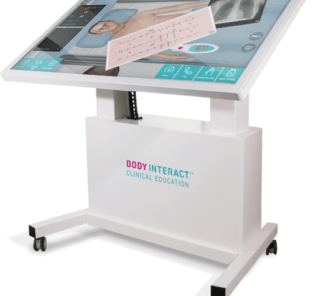Body Interact Virtual Patients Increases Retention By Over 20% – Immediately Deployable to Replace Clinical Rotations
As COVID-19 continues to spread around the world, healthcare educators are starting to overcome clinical rotation constraints by providing enhanced learning experiences with virtual patients. The good news is that over the past few years virtual patient simulation has already been introduced to educational institutions globally, and in some cases has already become demonstrated as a complementary learning tool in clinical education. Today we take a look at one HealthySimulation.com’s favorite desktop-based virtual patient simulation products aptly named Body Interact, and some of the new research which shows just how powerful it can be!
Most healthcare education institutions were never structured to deliver their programs remotely, but now faced with the Coronavirus pandemic the need has become immediate. Body Interact is a virtual patient simulator that enables current and future healthcare professionals to develop their clinical reasoning and decision-making skills, with simulated cases developed in conjunction with international medical experts.
Body Interact is a cloud-based software that can be used on multiple browsers and devices, making a student’s remote learning both portable and easily accessible. Body Interact’s virtual patient simulations have provided a distance learning solution that has supported and compensated educators and students as clinical rotations have been cancelled or suspended. Educators have been able to accelerate students’ clinical exposure with Body Interact through online classes and student’s individual practice and evaluations.
Sponsored Content:
How Body Interact Works
Body Interact is a dynamic patient simulator with a physiological algorithm that enables users to observe and understand how their decisions have an impact on the patient’s health condition, in real-time. It is both easy to use and intuitive, offering students a range of difficulty levels and complexity across cases. As a result, Body Interact is suitable for use in all institutions delivering medical education across Medicine, Nursing, EMS and Technical Schools, by complimenting and enhancing their programs and students learning experience in a simulated environment.
In order to support and facilitate remote online learning, clinical case practice and evaluations, Body Interacts Learning Management System ’’BI Studio” allows educators to track students’ ongoing progress and performance.
Sponsored Content:
Supported by the Research
The recent study Clinical Virtual Simulation in Nursing Education: Randomized Controlled Trial (Padilha et al.) has shown that Body Interact increases knowledge retention by 20.4% when compared to traditional methodologies. The researchers found that “the introduction of clinical virtual simulation in nursing education has the potential to improve knowledge retention and clinical reasoning in an initial stage and over time, and it increases the satisfaction with the learning experience among nursing students”. Certainly, Gamification improves new learners engagement and empowers students to develop further their clinical reasoning and decision making skills in a safe and virtual environment.
Body Interact users are completely responsible for the diagnosis and for the treatment plan according to the patient’s needs and health condition. From dialoguing with the patient, completing an ABCDE assessment or requesting tests, users can also call for other specialities, administer medication, and be responsible for their own clinical decisions.
After each clinical scenario the feedback section provides a step by step review of the user’s actions and how it has impacted on the patient’s health condition. In addition to the feedback provided, the user can also review their clinical competencies and understand what actions they missed, while performing the clinical scenario.
Features of Body Interact
- Can be utilized anytime, anywhere: The software is available 24/7 and runs in several devices (Windows device, iPad, iPhone, Web access)
- Get started immediately with pre-configured scenarios: The interactive scenarios are always ready to be used. Teachers can focus 100% on the students’ performance, observing and commenting their approaches.
- Real-time response to learner actions: Due to an advanced physiological algorithm, virtual patients react in real time to the user’s actions. Learners can observe the impact immediately – vital signs, test results and pharmacology interactions.
- Debriefing tools are built it: Detailed reports at the end of the simulation allow educators to provide a constructive debriefing session after each case, taking into consideration the timeline of the interventions, the performance score with penalties and the knowledge competencies accomplished.
- Included scenarios are already expert-reviewed: Clinical scenarios are developed alongside experts from top-medical societies, following the most recent well-established guidelines
- Visually appealing and interactive GUI: With a user-friendly interface, students and teachers find themselves engaged and focused on their approach to the virtual patients as if it was a real-life situation.
- A perfect supplement with manikins and task-trainers: A comprehensive learning experience is possible by combining virtual patients with other simulators. While Body Interact develops knowledge and complex cognitive operations such as perception, interpretation, judgment and decision making, manikins support the training through hands-on procedures and maneuvers.
An Extremely Helpful Tool Which Can Be Deployed Immediately During COVID-19
The COVID19 pandemic has not only disrupted the students institutional learning environment but has also reduced or completely limited their clinical rotation plans, therefore removing the possibility of practicing their theoretical knowledge on patients. Body Interact offers an integrated platform which facilitates remote learning, clinical practice and student evaluation. Additionally, educators can select specific scenarios (according to the teaching objectives) for students to train individually or in a group, anytime and anywhere, testing their skills and knowledge, and contributing towards team building and role play.
Visit the Body Interact Website to Learn More!
Sponsored Content:

















